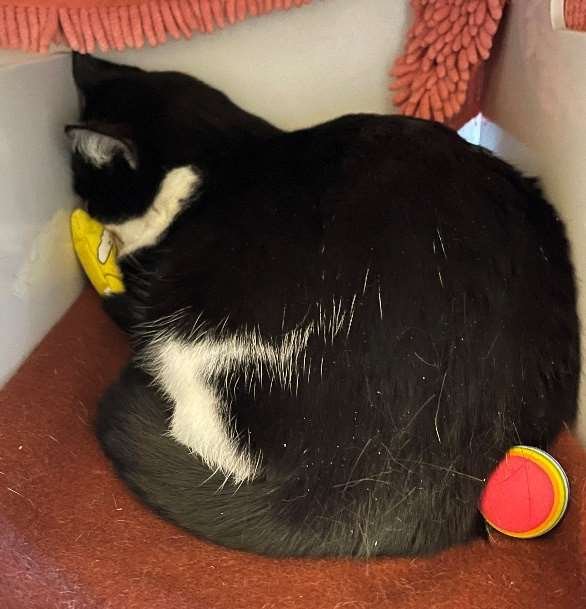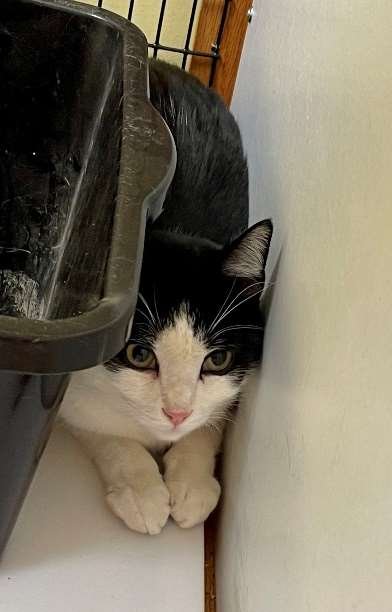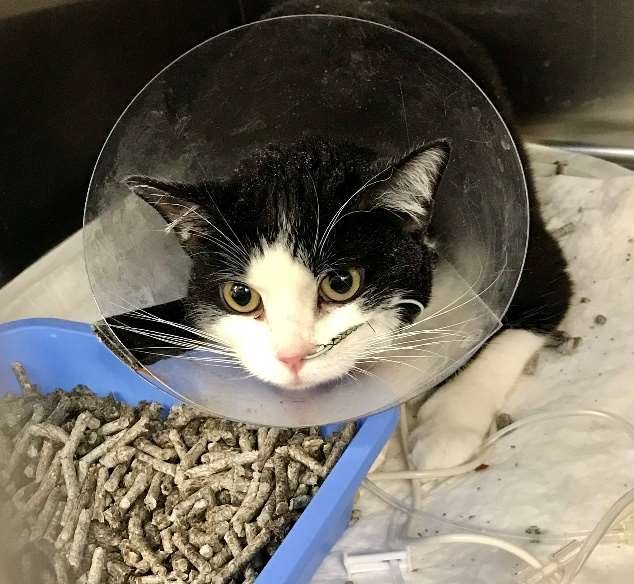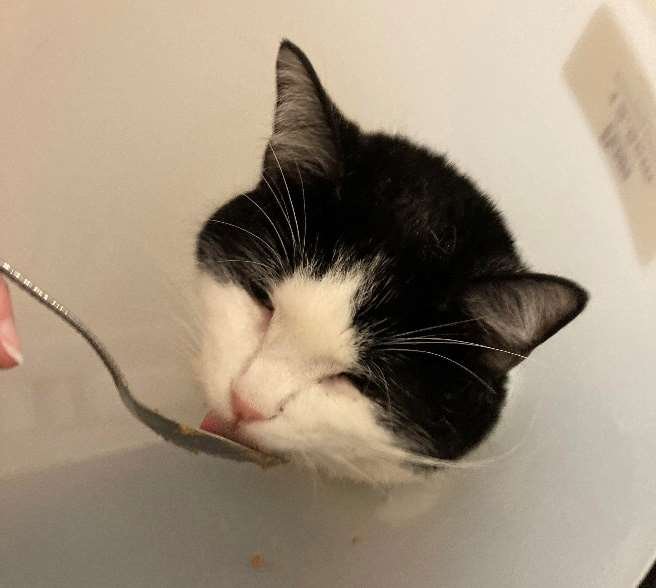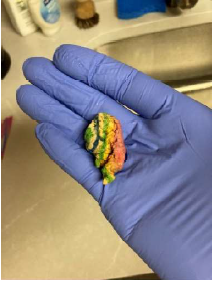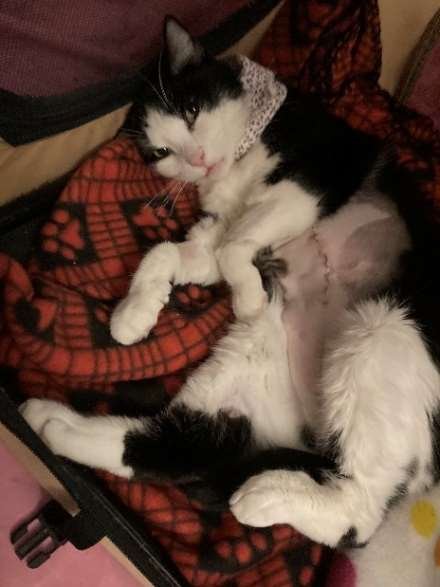The Story of Phineas - and the Rule of 3
In cat rescue, when a kitty is adopted, rescuers try to help the adopter understand the “Rule of 3”—3 Days to Decompress, 3 Weeks to Learn a New Routine, and 3 Months to Feel at Home.
Unfortunately, some adopters think that rescue volunteers and fosters are being overly cautious or dramatic and don’t trust the advice to follow the appropriate steps to properly acclimate their new kitty into the home. Sadly, especially in the case of kitties who started out wary of humans before being socialized by the rescuers, this often results in a failed acclimation and an unhappy kitty. Sadly, that often ultimately ends up in a return. The story of Phineas is a real-life example of this scenario.
Phineas will soon celebrate his fourth birthday. Our history with him goes back to late 2020 when in October, he and his brother Ferb became residents of Whiskers Way Station. They came to us as shy 6-month-olds needing some socialization. They quickly blossomed from all the love and attention they received from the snugglers at Whiskers Way Station. After a couple of months, both boys were adopted out to separate homes.
Phineas at 6 months old
Unfortunately, Phineas’ socialization did not continue in his new home. He had full run of the house, avoiding all human contact. Almost 2 years later we were asked to take him back as a return. We were shocked to learn that in the two years in her care, the adopter claims that she was never able to touch him. After that long without direct human contact, this poor boy had become a feral housecat!
We agonized over what had become of him and what his future would be. We just couldn’t see him as a barn cat. On a leap of faith, we agreed to welcome Phineas home to Whiskers Way Station. We had known and loved him. We also realized that we just might be his only hope.
Whiskers Way Station has a policy of not accepting cats as new residents until they have been in Stray Cat Blues foster care for at least two weeks. There are many reasons for this. Primarily, it is important to observe the cat’s behavior and evaluate the overall health of the cat before they can be introduced into our general population. But every once in a while, you just have to break the rules.
After being heavily sedated for a few days, Phin’s adopter was finally able to get him in a carrier and to the vet for a wellness check and vaccinations. He then came directly to Whiskers Way Station - groggy, fearful and confused. Phineas was allowed to decompress and slowly get reintroduced to the human touch by our volunteers at Whiskers Way Station. Phin was physically healthy, but he was an emotional mess. This was a very unusual case, and potentially dangerous for our volunteers. There was some hissing, an occasional swat or growl, but in between some soft contented purrs were heard. It would be a slow process, but our boy Phin was going to learn to trust and love people again.
Months were spent trying to make a connection with this defensive, confused boy. We got him to a point where he sometimes accepted pets and brushing, if you didn’t look at him directly. After months in a cage, he became depressed and then had a medical emergency. Phin had stopped eating, was listless, he didn’t respond negatively to being pet (very odd behavior for him!), and started vomiting huge amounts of clear liquid. He went to the ER that night.
Phin spent days in the hospital being tested and receiving supportive care. Unfortunately, he was sent home without a definitive diagnosis. Still not eating, and with our inability to medicate him, he was taken to one of our other vets for a second opinion. They were able to detect a foreign object in his gut. Immediately, Phin went to another veterinary hospital for emergency surgery.
What the surgeon found astonished everyone. Somehow, Phin had ingested an innocent looking foam ball! Of all the potentially dangerous toys, this would not have come near the top of the list. He came through his surgery with flying colors, but would need a lot of TLC to see him through his recovery.
Two of our socializers, Catie and Casey Massena, had developed a special relationship with Phin (on his terms), and offered to be his temporary medical fosters. They wanted to help with his physical and mental rehabilitation in their home. Phineas thrived in his home environment, making steady progress in his healing from surgery and with his re-socialization.
After a year in Catie and Casey’s care, Phin was accepted by their two resident cats and had become a beloved member of their family. In February 2024, they made it official! Phineas has been adopted and has his forever home! Yay Phin!!! 🎉 We don’t always get the perfect ending, but with luck and the right people we often come darn close.
A huge thank you to Catie & Casey!!!
Thankfully, Phineas’s story ultimately had a happy ending. But, many kitties never fully rebound from this type of experience. While it’s true that there are some cats who will acclimate much more quickly, it is always better to play it safe and take it slow. You will have the kitty’s lifetime to spend with them roaming free in your home. There is no need to rush things and risk a bad experience for both the cat and you.
Just remember the Rule of 3…!
3 Days to Decompress
While your kitty is decompressing, it’s imperative that you as the paw parent practice patience. During these first few days, as your cat transitions from the rescue or foster home to your home, he/she is being barraged by new sights and sounds, and a new level of stimulation. This transition can be overwhelming, especially for an adult cat who has already lost at least one home or a foster kitten who has only known one foster parent and foster room.
To ease this transition and minimize stress, it’s best confining your cat to one room initially that doesn’t have places where the cat can hide out of your reach, such as a bathroom. This limited space allows your cat to acclimate gradually, while also enabling you to monitor their eating, drinking, and litter box habits. It also provides opportunities for bonding and socializing, which are crucial in these early days.
It’s important to exercise patience during this period, as your new kitty may feel nervous initially. Many cats won’t eat much or at all the first day or two. Allow the kitty the time and space to adjust at his/her own pace. Even if you just sit in the room a few times a day and talk quietly to him/her, that is helping the kitty learn that you are safe.
Even if your cat appears confident and outgoing, keeping him/her confined for a few days helps the kitty familiarize themselves with their surroundings, including their litter box and scratching post, increasing the likelihood that they'll use them long term.
3 weeks to learn the new routine
During the first few weeks, the kitty will be studying your comings and goings, while you slowly begin to broaden their horizons. Cats love routine and will begin to know when to expect their meals, when it is bedtime, and when the best times are to snuggle with you. You can slowly begin to allow them to venture out of their room and start to explore more parts of the home at their pace.
By the three-week point, your kitty is likely becoming accustomed to your routines. As the kitty starts to venture out into more of the home, you can start to place familiar things from his/her room like scratching posts, litter boxes, toys, cat trees, and beds into other areas of the house to help the kitty feel more comfortable in his/her new environment.
3 months to feel at home
After three months, most cats will have settled into their new home. While we know how eager an adopter is to have their new kitty acclimated, the first couple of months requires patience. But, you will be rewarded with a happy kitty who has learned to trust you, if you are patient and navigate the kitty’s acclimation period successfully. The reward of earning and building a strong bond with your new fur baby will be immeasurable.
If you’d like to help us with socializing other kitties like Phineas so that they can live a safe, happy indoor life, you can donate items from our Amazon Wishlist that we need to care for the kitties at Whisker Way Station. Access the Wishlist by clicking the button below and look for the items that are noted “For WWS” in the comments.


